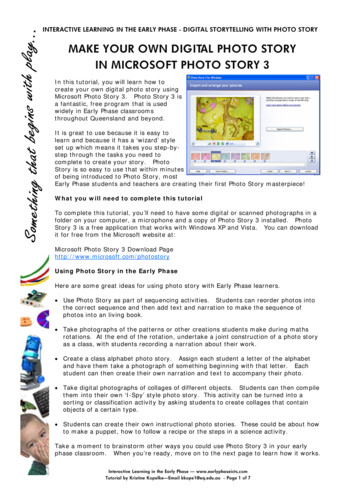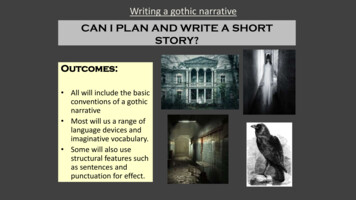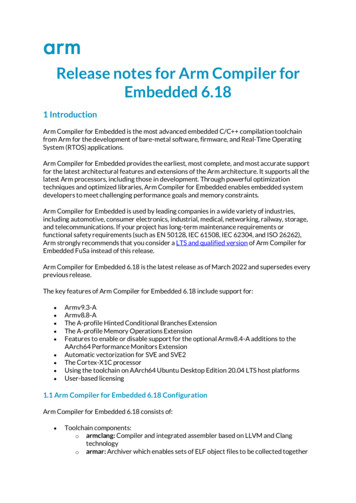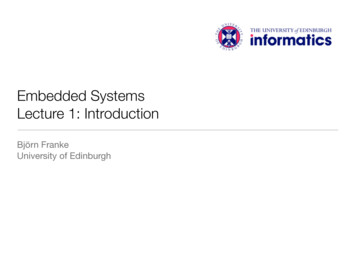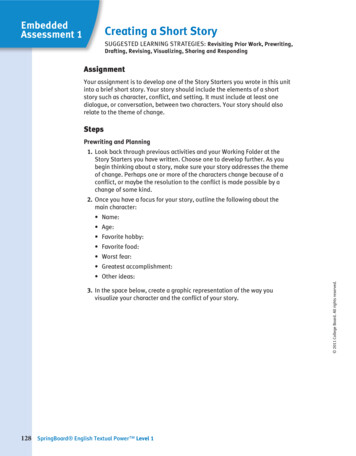
Transcription
EmbeddedAssessment 1Creating a Short StorySUGGESTED Learning Strategies: Revisiting Prior Work, Prewriting,Drafting, Revising, Visualizing, Sharing and RespondingAssignmentYour assignment is to develop one of the Story Starters you wrote in this unitinto a brief short story. Your story should include the elements of a shortstory such as character, conflict, and setting. It must include at least onedialogue, or conversation, between two characters. Your story should alsorelate to the theme of change.StepsPrewriting and Planning1. Look back through previous activities and your Working Folder at theStory Starters you have written. Choose one to develop further. As youbegin thinking about a story, make sure your story addresses the themeof change. Perhaps one or more of the characters change because of aconflict, or maybe the resolution to the conflict is made possible by achange of some kind.2. Once you have a focus for your story, outline the following about themain character: Name: Age: Favorite hobby: Favorite food: Worst fear: Greatest accomplishment:3. In the space below, create a graphic representation of the way youvisualize your character and the conflict of your story.128 SpringBoard English Textual Power Level 1 2011 College Board. All rights reserved. Other ideas:
EmbeddedAssessment 1continued4. Use the following graphic organizers (or create your own) to help youplan your story. Describe your character(s), the conflict, and the setting.In your plot description, include the conflict and its resolution. Write yournotes on separate notebook paper if needed. You will be turning in yournotes with your final draft of your short story.CharactersWhat does the character’s appearance say abouthim or her?Describe some of your main character’s actions.What do the character’s actions say about him orher?Other CharactersDetails About These Characters 2011 College Board. All rights reserved.Describe your main character’s appearance.Unit 2 Changes in My World 129
EmbeddedAssessment 1Creating a Short StorycontinuedConflict(s)External Conflicts: Conflicts Between the MainCharacter and Outside Forces (other characters,nature, etc.)Internal Conflicts: Conflicts Inside the CharacterSettingDescribe the sounds.Describe the textures of things in thesurroundings.Describe the scents (or odors!). 2011 College Board. All rights reserved.Describe what the setting looks like(include colors, objects, activities, etc.).130 SpringBoard English Textual Power Level 1
EmbeddedAssessment 1continuedPlotClimaxConflictong ActiFallinRisingActionPlot DiagramExposition 2011 College Board. All rights reserved.ResolutionDrafting5. Now that you have some plans for your story, use your notes to draft abrief short story that includes all the elements you have studied. Be sureyour story relates to the theme of change.6. Once you have drafted your story, explore different ways to tell yourstory. For example, experiment with different kinds of openings, such asdialogue, in the middle of action, or with a description of the setting. Youmight try writing the story from the point of view of different characters,as well as from the point of view of an outside narrator, to see whichone suits the story best. You might move your characters to a differentsetting. Try writing a different ending.7. Brainstorm titles that might get a reader’s attention. Consider uniquewords or phrases you have used in your story.Unit 2 Changes in My World 131
Creating a Short StoryEmbeddedAssessment 1continued8. Be sure to save all of your work; you might decide later that you want touse a discarded attempt after all.Revision Through Self-Assessment9. Read your short story quietly to yourself, correcting any mistakes thatyou notice along the way. Make sure your story sounds right.10. Compare the draft of your short story to the details on the graphicorganizers you completed to plan your story. You might have changedyour mind about some of your ideas once you got started writing, so besure to check to see if you left out any elements of the short story. If anyelements are missing or need more development, revise accordingly.11. Mark your draft as follows to evaluate where you may still need revision:a. Highlight (you may want to use different colors) the following elementsin your short story:C Transitions (words or phrases)C DialogueC Varied dialogue tagsC Descriptive details. If you have a small amount of highlighting, you will probably want torevise the elements to help your reader follow your story.c. Revisit the Assignment and the Scoring Guide and ask yourself howsuccessful you have been in meeting the criteria of the assignment.Make notes, either in the margin or by using sticky notes, of anyadditional changes you want to make.132 SpringBoard English Textual Power Level 1 2011 College Board. All rights reserved.b. Write Change in the margin next to to the place(s) where changeoccurs in the story. Your story must demonstrate the theme of change,either in your characters or in their surroundings.
EmbeddedAssessment 1continuedRevision Through Sharing and Responding12. Exchange stories with a partner. You and your partner will writecomments about each other’s stories. Once your partner has writtencomments about your story, read your partner’s comments and your selfevaluation. Which parts of your short story do you need to improve? Whatspecific improvements will you make?PARTNER DIRECTIONS: Read a copy of the entire short story very carefully;then respond to these questions/directions. Describe the main characters in the story. What did the writer do that helps you to visualize the main characters? Do the characters seem real? If not, what could the writer do to makethem seem more real? 2011 College Board. All rights reserved. What is the main conflict in the story? How is the conflict resolved? When and where does the story take place?Unit 2 Changes in My World 133
EmbeddedAssessment 1Creating a Short StorycontinuedRevision Through Sharing and Responding (continued) Is this setting described in a way that lets you imagine it? If not, whatcould the writer do to make the setting seem real? Does the dialogue in the story sound natural to you? What kind of change is addressed in the story?Editing and Publishing13. Rewrite your draft, incorporating the changes you identified and that yourclassmate identified.14. To create a publishable draft, edit your work to make it as error-free aspossible. Pay particular attention to the skills you learned in this unit:C Follow the rules of writing dialogue (refer to your list of dialogue tags).C Double-check the use and spelling of the words you used from theWord Wall.C Use all the other tools available to you to create an error-free draft.15. Following your teacher’s directions for formatting and publishing,produce a publishable draft of your short story.TECHNOLOGY TIP If you have access to a digital camera or a cellphone witha camera, you may want to take a photograph to illustrate some aspect ofyour short story.134 SpringBoard English Textual Power Level 1 2011 College Board. All rights reserved.C Check for correct grammar and punctuation.
EmbeddedAssessment 1continuedS coring GuideScoringCriteriaIdeasOrganization 2011 College Board. All rights reserved.Use ofLanguageExemplaryProficientEmergingThe short story hasnarrative elements thatinclude the following:The short story has narrativeelements that include thefollowing: a detailed, vivid setting characters who havedistinctive character traitsthat add to the narrative an inventive plot structurethat resolves the conflictin a way that connects tothe concept of change. a believable setting characters whohave character traitsappropriate to thenarrative a plot structure that has aresolved conflict.The short story effectivelyincorporates each elementof plot (exposition, risingaction, climax, falling action,and resolution).The short story includeseach element of plot(exposition, rising action,climax, falling action, andresolution).The short story is missingsome or all of the elementsof plot (exposition, risingaction, climax, falling action,and resolution).Transitional words orphrases seamlessly allowthe reader to follow thestory.Transitional words orphrases help the reader tofollow the story.Transitional words orphrases are missing.The dialogue is true to thecharacters’ persona/voiceand advances the plot.The dialogue helps portraycharacter and conflict.The dialogue is missing ordoes not show aspects ofcharacter or conflict.Descriptive details allowthe reader to visualize thesetting, characters, andaction.Details allow the readerto visualize the setting,characters, and action.The short story isunderdeveloped andmissing some or all ofthe following narrativeelements: a believable setting characters whohave character traitsappropriate to thenarrative a plot structure that hasa resolved conflict.Descriptive details aremissing and/or do not allowthe reader to visualize thesetting, characters, andaction.Unit 2 Changes in My World 135
EmbeddedAssessment 1Creating a Short StorycontinuedScoring GuideScoringCriteriaConventionsExemplaryThe writer demonstratescommand of dialogueconventions.Overall, the story has fewor no errors in spelling,punctuation, capitalization,and grammar.Evidence ofthe WritingProcessThe story demonstratesthoughtful planning,significant revision,and careful editing inpreparation for producing apublishable draft.ProficientAlthough a few errors indialogue conventions mayexist, they do not interferewith meaning or distract thereader.EmergingSeveral errors in dialogueconventions appear inthe text. The errors aredistracting to the reader.Overall, the story’s spelling,punctuation, capitalization,or grammar mistakes do notdetract from the story.Overall, the story hasspelling, punctuation,capitalization, or grammarmistakes that detract frommeaning and/or readability.The story demonstratesplanning, revision, andediting to produce a draftthat is ready for publication.The story does not showevidence of planning anddisplays minimal revisionand editing.The draft is not ready forpublication.Comments:136 SpringBoard English Textual Power Level 1 2011 College Board. All rights reserved.AdditionalCriteria
Your assignment is to develop one of the Story Starters you wrote in this unit into a brief short story. Your story should include the elements of a short story such as character, conflict, and setting. It must include at least one dialogue, or conversation, between two characters. Your story should also relate to the theme of change. Steps



